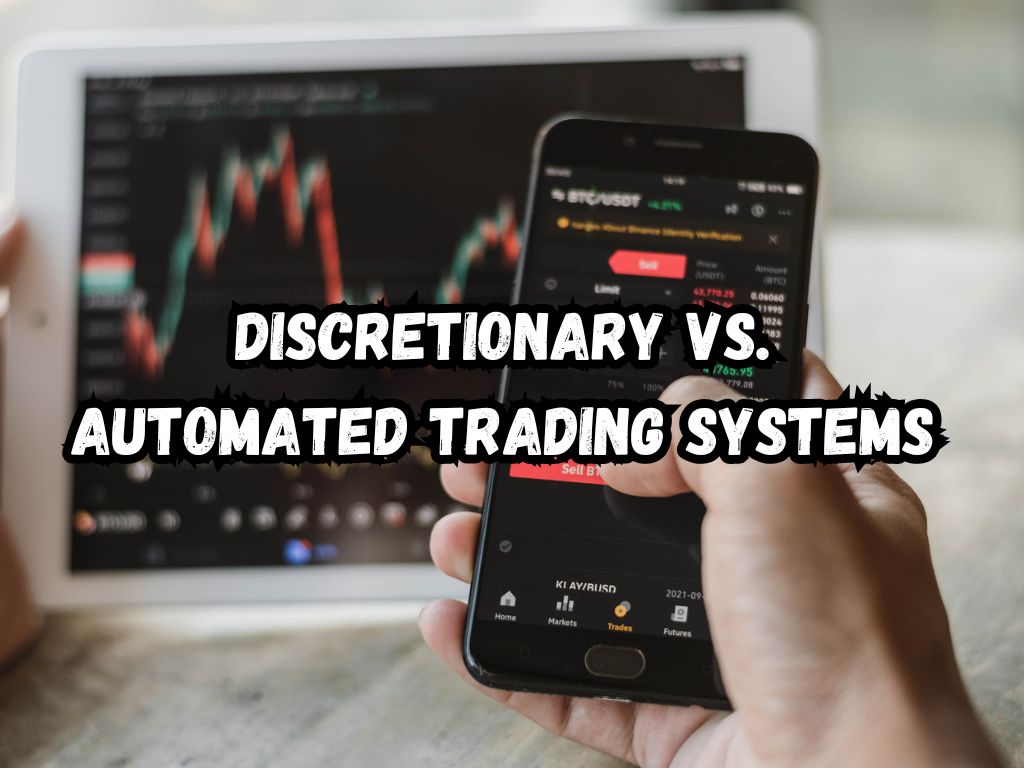In the evolving world of stock trading, investors constantly search for efficient strategies to maximize their returns.
Two prominent approaches that stand out are Discretionary and Automated Trading Systems.
While both strategies offer unique benefits, understanding their differences is crucial for traders to identify which one aligns with their investment style, goals, and risk tolerance. Let’s learn the difference, discretionary vs automated trading systems.
What is Discretionary Trading?
Discretionary trading relies on human judgment for making trading decisions. Traders analyze the market, using their experience, intuition, and research to buy or sell securities. This method grants traders the flexibility to adjust their strategies based on market conditions, news, and other qualitative factors that might impact asset prices.
One of the main advantages of discretionary trading is its adaptability. Traders can pivot their strategies in real-time, catching opportunities that might not fit into a predefined algorithm. This human element allows traders to assess nuanced market sentiments, something purely data-driven systems might miss.
However, discretionary trading is not without drawbacks. It is subject to emotional biases and human errors, potentially leading to inconsistent results.
Moreover, it demands significant time and effort for market analysis and staying updated with financial news.

What is Automated Trading?
Automated trading systems operate on algorithms that execute trades based on predefined criteria, without the need for human intervention.
These systems analyze market data to identify trading opportunities that meet the set parameters, such as price movements or volume changes, and automatically execute trades.
The primary advantage of automated trading is its ability to remove emotions from the trading process, leading to more consistent decision-making. Furthermore, these systems can process vast amounts of data quickly, execute trades at optimal prices, and monitor multiple markets simultaneously.
Automated systems also allow for backtesting, enabling traders to validate their strategies against historical data before applying them in live markets.
However, automated trading comes with its own set of challenges. It may overlook qualitative aspects of trading, such as geopolitical events or company leadership changes, which could be crucial for decision-making.
There’s also the risk of over-optimization, where a strategy might perform well on historical data but fail in real-world conditions. Technical failures, such as connectivity issues or software bugs, can also disrupt trading activities.
Discretionary vs Automated Trading Systems
When comparing both trading systems, it’s evident that each has its benefits and limitations. Discretionary trading allows for a degree of flexibility and qualitative judgement that automated systems lack. On the other hand, automated trading excels in speed, precision, and eliminating emotional bias from the trading process.
Key Considerations in Choosing a Trading System
Choosing between discretionary and automated trading depends on various factors. It requires assessing personal preferences, skill sets, and the time one can dedicate to trading.
Those who enjoy research and have the ability to interpret market conditions might lean towards discretionary trading.
On the contrary, traders looking for efficiency and consistency might prefer automated systems. Moreover, the choice also depends on one’s risk tolerance and trading goals.
Short-term traders might favor automated trading for its ability to capitalize on quick market movements, whereas long-term investors could prefer the discretion and flexibility of manual trading.
Developing a Mixed Approach
In some cases, traders combine the strengths of both discretionary and automated trading.
This hybrid approach allows traders to leverage the efficiency and precision of automated systems while retaining the ability to make discretionary decisions when necessary.
For instance, one could use an automated system for entry and exit points but decide on the trade size manually.
Best Practices for Implementing Trading Systems
Regardless of the trading system chosen, certain best practices can enhance its effectiveness.
It’s vital to have a deep understanding of the system, whether it’s learning the intricacies of market analysis for discretionary trading or developing the skills to create and tweak algorithms for automated systems.
Setting clear rules and risk management protocols can help mitigate potential losses. Lastly, consistent review and learning from past trades are essential for refining strategies and adapting to market changes.
Guidelines for Discretionary Traders Adopting Automation
Discretionary traders looking to incorporate automation should start with automating repetitive tasks, such as trade execution, while still relying on manual analysis for decision-making.
Balancing automated signals with personal judgement allows for a smoother transition to more complex automated systems.

Guidelines for Automated Traders Incorporating Discretion
For traders relying on automated systems, incorporating discretion might involve manually reviewing trades suggested by the algorithm or adjusting parameters based on current market insights.
This approach ensures that automated decisions are in line with broader market conditions and trader’s insights.
Frequently Asked Questions
How do I know if discretionary trading or automated trading is right for me?
Assess your personal preferences, expertise in market analysis, and your willingness to engage actively in trading. Your answer will depend on the level of involvement and control you wish to have over your trades.
Can a beginner trader start with an automated system?
Yes, a beginner can start with automated trading, especially if they lack the time or expertise for comprehensive market analysis. However, understanding the basics of the system and market principles is crucial before relying on automation.
What are the costs involved in setting up an automated trading system?
Costs can vary depending on whether you’re using off-the-shelf software or developing a custom system. Additionally, there might be costs for data feeds, historical data for backtesting, and possibly software or hardware upgrades.
How do I measure the success of my trading approach?
Success can be measured in terms of profitability, consistency of returns, and adherence to predefined risk management rules. Comparing performance against market benchmarks can also provide insights into the effectiveness of your trading strategy.
Is it possible to completely eliminate emotions from trading?
While automated trading can significantly reduce emotional decision-making, it’s challenging to eliminate emotions entirely, especially when reviewing performance or making adjustments to strategies. The key is to develop disciplined trading habits and risk management protocols.
Conclusion
Both discretionary and automated trading systems have a place in the realms of trading. The choice between them should rest on an individual’s trading style, preferences, and goals.
Perhaps the most effective approach lies in harnessing the strengths of both systems—leveraging automation for efficiency and consistency while applying human judgment for flexibility and nuanced decision-making.


 Tags:
Tags:










